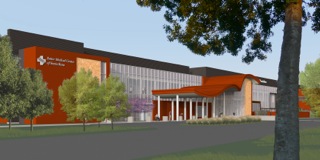Subscribe Now
Integrated Project Delivery: The Design, Construction Methodology for Greater Communication, Consensus Building
 By Bill Whipple
By Bill Whipple
In recent years, the design and construction methodology for medical facilities has undergone a fundamental cultural shift, because of an innovative process called Integrated Project Delivery. Traditionally, the goals of the various design and construction professionals have not always been aligned. An architectural team designed the facility, construction professionals built the structure and other subcontractors installed medical equipment, furniture and other devices. In doing so, a lot of waste occurred in terms of unnecessary effort, rework and paperwork. IPD changes all of that.
IPD brings key participants from each of the professions to the table from day one. These multi-disciplinary project teams openly communicate and collaborate with one primary goal in mind: To achieve lean, highly efficient design and construction by optimizing the entire project, not just each piece or component. Because everyone on the project team is aligned with the same goal — to remove waste and add value — adversarial relationships are eliminated, team members are resourceful, trust is established and work processes are refined. As a result, the client realizes savings in terms of time, materials and money.
IPD is the methodology being used in the design and construction of the new Sutter Medical Center in Santa Rosa, Calif., designed by HGA Architects and Engineers and built by Unger Construction. Most healthcare facilities, are extremely complex to design and build. Like a battleship or aircraft carrier, they’re large, complicated structures. They have their own heating and cooling central plants, advanced communications systems and tracking systems.
Social interrelationships between staff and departments are also complex. Healthcare facilities have isolated silos of specialists and specialties (such as radiology). Medical facilities, especially in California, are also highly regulated. To address these realities from the start, members of the Sutter Medical Center project team signed an integrated contract to share responsibility for cost containment, with built-in incentives for completing work on schedule and under budget.
The IPD planning stage began with a set of targeted principles, such as a not-to-exceed maximum facility cost and schedule milestones. Using Building Information Modeling, the architects created a computer-generated 3-D simulation of the facility’s design. This virtual model allowed team members to work out details, avoid or overcome obstacles, maximize efficient scheduling and discover cost-effective solutions. The model is being continuously updated to eliminate delays and ensure seamless workflow.
The BIM model also fosters a deeper, more efficient working relationship between the architect designing the project and the contractor building the facility.
In addition, the IPD process creates a heightened awareness of the entire process for all team members. Every week, from 40 to 50 team members meet to share information, in order to achieve the best results and increase value by reducing waste, improving productivity, streamlining construction and achieving shorter delivery times throughout the project’s lifecycle. As a result, some project components are prefabricated offsite, where contractors have a more productive, safe and controlled environment.
The IPD approach also included hospital employees, who provided valuable input on work processes and design preferences. Such factors as nurse-to-patient ratios, hospital process flow and operational and maintenance efficiencies were considered by the IPD teams during design and construction.
IPD is a cultural shift. Teams get to know each other and improve together, on behalf of shared values and incentives related to the project. Team members are aligned toward the same goal: greater efficiency and effectiveness. As a result, the design, construction and healthcare professions no longer compete with each other; instead, the competitor is inefficiencies (waste in time, materials and costs). The real winner is the client, who can advance the healthcare delivery system and provide high-quality care at an affordable price.
Bill Whipple, LEED AP, is a medical planner with HGA Architects and Engineers.
Tags:
Posted April 19, 2012
More Articles:
- Coverings 2024
Apr 22, 2024 – Apr 25, 2024 - Hospital, Outpatient Facilities & Medical Office Buildings Summit
Apr 25, 2024 – Apr 25, 2024 - CxA Workshop & Exam
Apr 29, 2024 – Apr 30, 2024 - EMP Seminar & Exam at CxEnergy 2024
Apr 29, 2024 – Apr 30, 2024 - CxEnergy
Apr 29, 2024 – May 2, 2024 - PHCC West 2024
Apr 29, 2024 – May 2, 2024 - Lean in Design Forum 2024
May 1, 2024 – May 2, 2024










